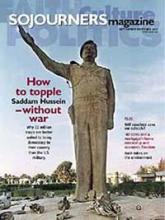'Nonviolent resistance isn't about making a point, it's about taking power." Even many people who believe deeply in nonviolence might be taken aback by the bluntness of such a statement. Most students and practitioners of nonviolence know that just because it's a moral principle does not mean that its value is merely symbolic. Still, common popular images often focus on quixotic nonviolent gestures, not techniques that can be put to long-term, strategic use. It is too often brushed off as a noble, but ineffectual, approach to the problems of the real world. Peter Ackerman and Jack DuVall, co-authors of A Force More Powerful: A Century of Nonviolent Conflict, absolutely reject such romanticizing and diminishment of nonviolent techniques. Nonviolence is powerful, they argue. Powerful enough to face off against even brutal dictators. In this issue, they make the case that civilian-based, nonviolent resistance by the Iraqi people is a viable, practical way to remove Saddam Hussein from power.
It's not the United States' right to decide unilaterally that Saddam should be "dethroned" and to launch a military invasion to do so (thus inflicting more suffering on an already beleaguered and sanction-weakened populace). It is, however, a decision that is the right of Iraqi citizens, who have been brutalized and repressed by Saddam for more than 20 years. Even under duress, they could demonstrate a force more powerful than our weaponry or Saddam's oppression. -The Editors
Read the Full Article
